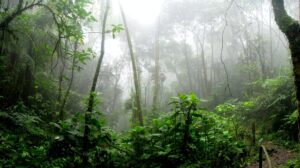Physical Address
23,24,25 & 26, 2nd Floor, Software Technology Park India, Opp: Garware Stadium,MIDC, Chikalthana, Aurangabad, Maharashtra – 431001 India
Physical Address
23,24,25 & 26, 2nd Floor, Software Technology Park India, Opp: Garware Stadium,MIDC, Chikalthana, Aurangabad, Maharashtra – 431001 India

By Aayushi Sharma
According to a study by World Weather Attribution, “the primary factor behind the severe drought in the Amazon last year was determined to be climate change induced by human activities.” The drought, affecting all nine Amazon rainforest nations, including Brazil, Colombia, Venezuela, and Peru, is anticipated to intensify in 2024 as the rainy season diminishes starting May.
Amazon Rainforest: the lungs of the earth
The Amazon rainforest, often referred to as the “lungs of the Earth,” is a vast and dense tropical rainforest located in South America. It is home to an incredibly diverse array of flora and fauna, with estimates of around 390 billion individual trees belonging to approximately 16,000 different species. The Amazon river basin harbors the world’s largest rainforest, a critical global hub for biodiversity and a vital component of the worldwide hydrological and carbon cycle.
What does the study say?
Presently, river levels have plummeted to their lowest in 120 years, posing a threat to the approximately 30 million inhabitants in the Amazon basin across nations like Brazil, Peru, Colombia, Venezuela, Ecuador, and Bolivia. This jeopardizes their lives by disrupting transportation, isolating communities, and causing harm to wildlife.
The extensive river system is a major energy source for many countries through hydropower. Brazil heavily relies on hydro power for 80% of its electricity, followed by Colombia at 79%, Venezuela at 68%, Ecuador and Peru at 55%, and Bolivia at 32%. The drought is significantly impacting dam capacities and energy output, leading to power cuts in the region since June 2023.
Scientists from Brazil, the Netherlands, the UK, and the US have employed published peer-reviewed methods to assess the influence of climate change and the occurrence of El Niño on the drought. Although the drought initially began in the western part of the basin, the entire basin has experienced severe or exceptional drought conditions in the latter half of the year.
Drought characterization involves multiple approaches. Meteorological drought focuses solely on low rainfall, while agricultural drought combines rainfall estimates with evapotranspiration. Increased evapotranspiration due to regional warming can worsen drought impacts. This study evaluates agricultural drought using the Standardized Precipitation Evapotranspiration Index (SPEI) and meteorological drought using the Standardized Precipitation Index (SPI). Negative values in SPEI indicate more severe drought conditions.
Key findings of the study:
The drought has disproportionately impacted highly vulnerable populations, particularly small-holder farmers, indigenous communities, rural dwellers, and river communities in the region. These groups, already burdened by high poverty rates, face heightened vulnerability due to their heavy reliance on agricultural food production, freshwater availability, and the import of goods via rivers. Historical practices such as deforestation, vegetation destruction, fires, biomass burning, corporate farming, and cattle ranching have compounded their exposure to drought impacts, diminishing the land’s water and moisture retention capacity, thereby exacerbating drought conditions.
Examining weather records-based datasets reveals the exceptional nature of the drought, even in today’s climate. Meteorological drought, characterized by the Standardized Precipitation Index (SPI), is deemed a 1 in 100 year event, while the Agricultural Standardized Precipitation Evapotranspiration Index (SPEI) designates it as approximately a 1 in 50 year event. The data points to a robust drying trend in meteorological drought, but agricultural drought exhibits an even more pronounced trend, suggesting that this level of agricultural drought would have been exceedingly rare in a cooler climate.
The investigation explores the impact of El Niño as a potential factor in the observed trend. Although El Niño played a role in reducing precipitation in the region, its influence was nearly equivalent to that of climate change. However, the primary driver behind the severity of the severe drought is largely attributed to elevated global temperatures, underscoring the dominant role of climate change in this current drought crisis.
In order to gauge the impact of human-induced climate change on the drought, a thorough analysis integrates observation-based data products and climate models, assessing both 6-month meteorological drought (SPI6) and agricultural drought (SPEI6). The results unveil a significant surge in the likelihood of meteorological drought by a factor of 10, while agricultural drought has become approximately 30 times more probable. According to the US drought monitoring classification system focusing on agricultural drought, the current exceptional drought (D4) would only have been classified as a ‘severe drought’ (D2) if not for the effects of climate change induced by fossil fuel burning and deforestation.
The outlook for the future appears bleak unless there is a prompt halt to fossil fuel burning and deforestation. In a world 2°C warmer than pre industrial levels, events like the ongoing drought would become even more recurrent, with agricultural drought occurring every 10-15 years (an additional factor of 4) and meteorological drought every ~30 years (an additional factor of 3).
Despite having existing drought management plans, recent events underscore the imperative to revamp policies. This involves integrating proactive support for forecasts, early warnings, drought contingency plans, sustainable water management practices, and infrastructure investment. Such reforms are critical to address the challenges posed by future, more intense droughts. The findings stress the urgency for effective water management strategies, interdisciplinary humanitarian responses, and regional cooperation that actively involves farmers and other stakeholders in the planning process.
While there may be ‘low confidence’ in IPCC projections for drought in the region, the escalating water stress fueled by human-induced climate change remains a significant threat requiring immediate and comprehensive efforts. The increasing urgency to confront this issue is evident, and it emphasizes the need for a multifaceted approach to mitigate the impacts of climate change and safeguard vulnerable communities from the perils of prolonged drought conditions.
References:
Images: